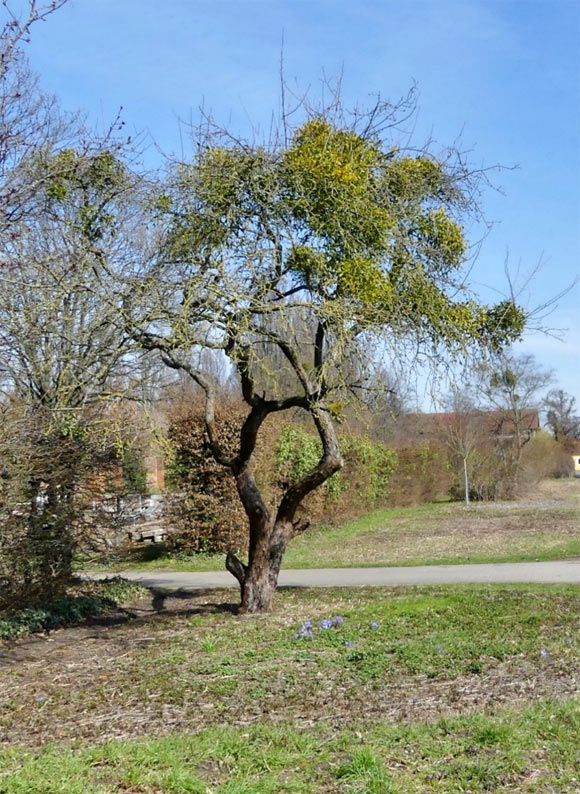The European mistletoe (Viscum album) is a hemiparasitic flowering plant steeped in ancient associations with druids and Northern European folklore. Since the mistletoe genome is extremely large (estimated 30 times larger than the human genome and 600 times larger than the genome of the model plant Arabidopsis thaliana), it has not been sequenced up to now.

A female European mistletoe (Viscum album) plant in winter in the Herrenhäuser Gardens in Hanover, Germany. Image credit: Schröder et al., oi: 10.1111/tpj.15558.
The European mistletoe is an obligate hemiparasitic flowering plant that grows on branches of various trees.
It is supplied with water, minerals and organic compounds from the host. At the same time, it carries out photosynthesis and produces energy-rich compounds.
The mistletoe is widely distributed in central and northern Europe. It nicely is visible from November to March because it belongs to the few flowering plants that do not discard their leaves in the European winter.
In fact, the plant is photosynthetically active at temperatures below the freezing point.
The mistletoe can cause problems in tree vitality, especially in combination with water stress. However, under favorable growth conditions, host trees are only moderately affected and can well coexist with the hemiparasite.
It also has important ecological functions. Its flowers and berries ripe in winter and are a nutritional source for several insects and birds.
Compared to other flowering plants, the life cycle of the European mistletoe is characterized by numerous remarkable features:
(i) it does not germinate in soil but on branches of trees, which requires particularly ‘sticky’ fruits (berries) that stably attach to tree bark;
(ii) seeds consist of an embryo but lack a seed coat;
(iii) embryos can germinate directly from the berry (without a dormancy phase);
(iv) the direction of initial shoot growth is not determined by positive but rather negative phototropism, which guides the shoot onto the surface of the branch of the host tree;
(v) the shoot afterwards penetrates the branch and gets connected to the xylem of the vascular system, where it forms a haustorium for uptake of water, minerals and organic compounds;
(vi) the dichotomous mistletoe plant, which afterwards develops, forms one pair of shoot segments per year per shoot apical meristem and two comparatively simply organized leaves, which resemble primary leaves;
(vii) shoots grow into all directions, giving rise to the typical ball-like shape of the adult plant;
(viii) in contrast to the leaves of the host tree, mistletoe leaves do not close stomata during water shortage (which may dramatically increase water stress of host plants);
(ix) older leaves of the previous growth periods are discarded in September without preceding chlorophyll recycling;
(x) leaves of the current growth period are kept during winter and perform photosynthesis;
(xi) fruit ripening and seed dispersal take place in winter.
The European mistletoe also has a particular biochemical composition.
It is known for its rich content in phenolic acids, phenylpropanoids, flavonoids, triterpenes and phytosterols.
It contains low-molecular-mass proteins designated viscotoxins as well as characteristic lectins (viscolectins), both of which contribute to its biotic defense system.
The glue-like substances present in mistletoe berries mainly consist of hemicellulose compounds. It is clear but hardly addressed by scientific investigations that the development of mistletoe is based on a very unusual distribution of phytohormones.
Extracts of the European mistletoe have cytotoxic and immune-stimulating effects and are used in medicine.

The European mistletoe (Viscum album) growing on an apple tree at the campus of Leibniz University Hannover in Hanover, Germany; different organs harvested from this tree in summer and in winter were used for the study; the photo was taken in winter (February). Image credit: Schröder et al., oi: 10.1111/tpj.15558.
Due to genome size and the amount of repetitive DNA, determination of the mistletoe genome sequence remains challenging.
Therefore, the reserach team led by Dr. Hans-Peter Braun of the Leibniz Universität Hannover’s Institute of Plant Genetics decided to firstly characterize the mistletoe gene space — defined as the space including and surrounding genic regions.
“We used a trick: the genome, which consists of DNA, was not analysed directly,” they explained.
“Instead, transcripts of the genome (RNAs), which code for the mistletoe’s proteins, were isolated and transcribed into DNA using enzymes.”
“The resulting shorter DNA molecules could then be subjected to systematic sequence analysis.”
The authors were able to determine 39,092 mistletoe gene sequences encoding 32,064 proteins.
Among them are numerous known enzymes that are generally important for life processes in plants, but also special mistletoe proteins, such as viscotoxins and viscolectins, which are considered to possess significant medicinal potential.
Furthermore, the researchers were able to demonstrate that the protein-coding sections of the mistletoe genome is characterised by a particularly high stability compared to DNA of other flowering plants.
“We can learn a lot from studying parasites and semi-parasites since they do not have to carry out all life processes themselves,” Dr. Braun said.
“If certain structures are missing, it becomes clearer what they are good for and how exactly they function.”
The team’s results were published in the Plant Journal.
_____
Lucie Schröder et al. The gene space of European mistletoe (Viscum album). Plant Journal, published online October 29, 2021; doi: 10.1111/tpj.15558







